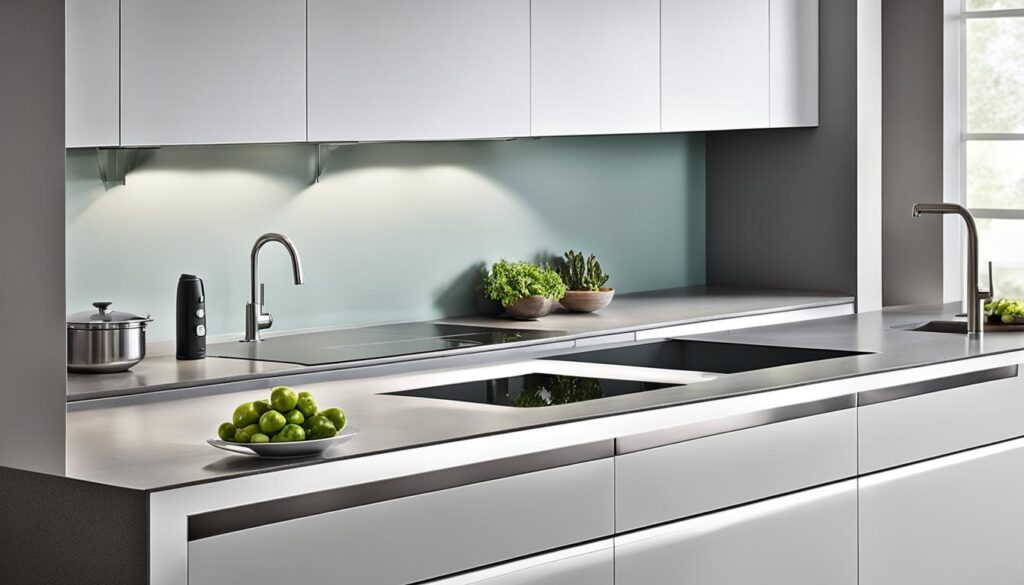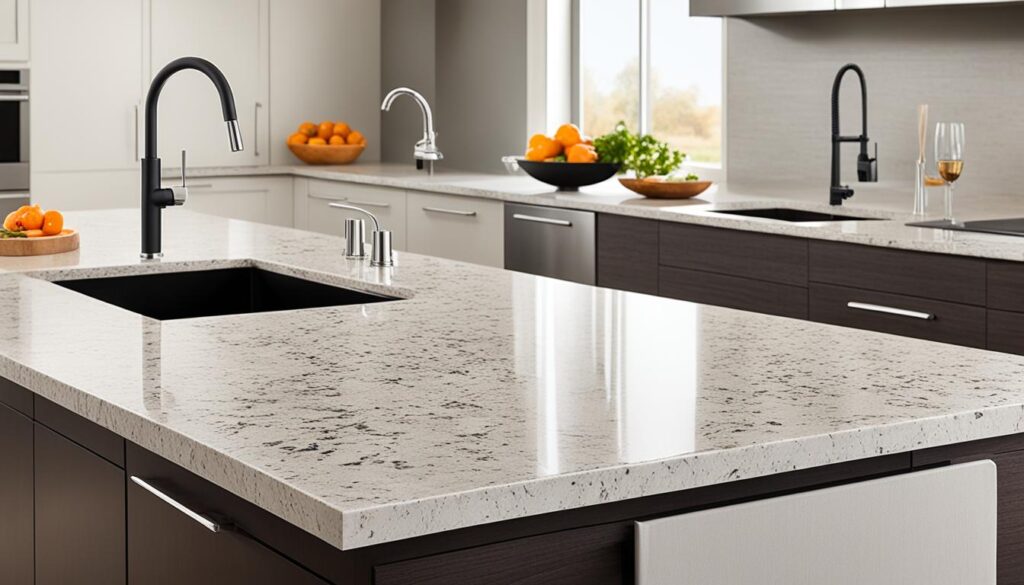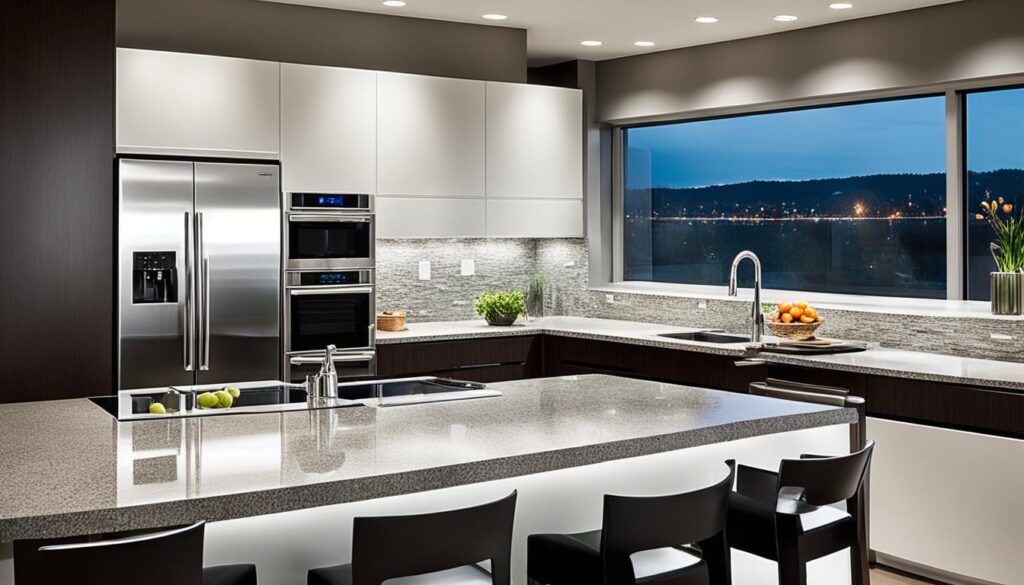When it comes to kitchen design, having enough electrical outlets for all your appliances and devices is essential. In this guide, I will explore different options for kitchen countertop outlets, including traditional outlets, pop-up outlets, and hidden outlets. We will discuss the importance of outlet placement, safety considerations, and design options to help you create a sleek and functional kitchen space.
Key Takeaways:
- Kitchen countertop outlets are crucial for a functional kitchen design.
- There are various options, including traditional outlets, pop-up outlets, and hidden outlets.
- Outlet placement and safety considerations are important factors to consider.
- Choose outlets that complement your kitchen’s style and enhance the overall aesthetic.
- Follow electrical codes and regulations for safe installation.
Outlet Placement and Design Considerations
When planning the placement of your kitchen countertop outlets, it is important to consider both functionality and design. Traditional outlets can be installed directly on the wall or incorporated into the countertop. Plug mold kitchen countertop outlets offer a discreet and streamlined option, allowing you to hide the outlets under the cabinets or behind appliances. Countertop receptacles provide easy access to power without cluttering the space. Hidden kitchen outlets, like pop-up outlets or those installed inside cabinets, can maintain a clean and uncluttered aesthetic. Consider the layout of your kitchen, the appliances you use most frequently, and the overall design style to determine the best outlet placement for your needs.
Installing traditional outlets on the wall or countertop can be a straightforward and practical choice. They are easily accessible and can be installed at a suitable height for your convenience. However, they may interrupt the visual flow of your kitchen design, especially if you have a minimalist or contemporary style.

Plug mold kitchen countertop outlets offer a clever solution for hiding outlets and keeping your kitchen countertops clutter-free. These outlets are installed beneath the cabinets or behind appliances, providing discreet power access. They can be easily concealed, making them a popular choice for homeowners who want a clean and unobtrusive kitchen design.
Another option to consider is countertop receptacles. These outlets are designed to be placed directly on the countertop surface, providing convenient access to power without any visible wiring or cords. Countertop receptacles are ideal for small appliances that are frequently used on the countertop, such as blenders or toasters. They can be installed discreetly and don’t disrupt the visual flow of your kitchen.
If you prefer a truly hidden outlet solution, hidden kitchen outlets may be the answer. These outlets are designed to blend seamlessly into your kitchen design. They can be installed inside cabinets or drawers, ensuring that power is easily accessible without compromising the aesthetics of your kitchen.
Design Considerations
When considering outlet placement, it is important to take into account the layout and workflow of your kitchen. Think about where you typically prepare food, where your appliances are located, and where you need access to power the most. Placing outlets close to these areas will ensure convenience and functionality.
Additionally, consider the overall design style of your kitchen. If you have a modern or minimalist kitchen, you may opt for hidden outlets that maintain a clean and uncluttered look. Alternatively, if you have a traditional or rustic kitchen, you may choose to incorporate outlets that blend in with the overall aesthetic.
Summary
When planning the placement of your kitchen countertop outlets, consider both functionality and design. Traditional outlets, plug mold outlets, countertop receptacles, and hidden kitchen outlets all offer unique advantages and design possibilities. Choose the outlet type that best suits your needs and complements your kitchen’s style. With careful consideration and planning, you can achieve a functional and visually appealing kitchen space.
Types of Kitchen Countertop Outlets
When it comes to kitchen countertop outlets, there are various options available to suit your specific needs and preferences. Whether you prioritize convenience, aesthetics, or functionality, there’s a type of outlet that can meet your requirements. Let’s explore some popular choices:
Countertop Power Outlets
Countertop power outlets are a versatile and straightforward option. These outlets can be installed directly on the surface of your countertops, providing easy access to power for small appliances and devices. They are a practical choice, ensuring that you can conveniently plug in and use your kitchen gadgets without the hassle of cords trailing across your workspace.
Under Cabinet Outlets
If you prefer a clutter-free kitchen countertop, under cabinet outlets are an excellent solution. These outlets are hidden beneath your cabinets, keeping your countertops clear of cords and creating a clean and streamlined look. With under cabinet outlets, you can enjoy a more elegant and organized kitchen space.
Kitchen Island Outlets
For those with a kitchen island, specific outlets can be integrated into the surface or placed on the side for easy access. Kitchen island outlets offer convenience when using appliances or charging devices on your island. They can be seamlessly incorporated into the design, ensuring that your island remains both functional and aesthetically pleasing.
In-Counter Outlets
If you prefer a truly sleek and seamless look, in-counter outlets are an ideal choice. These outlets are recessed into the countertop, creating a flush and streamlined appearance. In-counter outlets allow you to maintain a clutter-free kitchen while still having access to the power you need.
By considering the different types of kitchen countertop outlets, you can select the one that best fits your needs and complements your kitchen design. Whether you prioritize convenience, aesthetics, or functionality, there’s a perfect outlet option for you.

“Having the right type of kitchen countertop outlets not only enhances the functionality of your kitchen but also adds to its overall appeal. Choose outlets that align with your needs and preferences, making your kitchen a convenient and inviting space.” – Karen Stevens, Interior Designer
Safety Considerations for Kitchen Countertop Outlets
Safety is of utmost importance when it comes to kitchen countertop outlets. Proper installation and adherence to local electrical codes and regulations are essential to ensure the safety of your home and family. Additionally, considering specific safety features and precautions can further protect against electrical shock and potential hazards.
One important safety measure to consider is the use of GFCI outlets (Ground Fault Circuit Interrupter). These outlets are designed to automatically cut off the power supply if they detect an imbalance in the electrical current. GFCI outlets provide an extra layer of protection against electrical shock, making them highly recommended for kitchen countertop outlets.
If you opt for plug mold outlets, it is crucial to ensure proper installation and adherence to safety standards. Plug mold outlets are a popular choice for kitchen countertops due to their discreet design and ability to hide unsightly cords. However, it is important to select high-quality plug mold outlets that meet safety standards, as poorly installed or faulty outlets can pose a risk.
When installing and placing outlets in your kitchen, it is essential to avoid placing them near water sources, such as sinks or behind cooktops. Water and electricity do not mix, and exposure to moisture increases the risk of electrical shock and short circuits. Ensuring a safe distance between outlets and water sources is a crucial safety consideration.
Another important aspect to consider is selecting outlets that are compatible with the specific plugs and appliances you will be using in your kitchen. Different appliances may have specific power requirements, and using incompatible outlets can lead to electrical issues and potential hazards. Consult with an electrician to ensure that the outlets you choose meet the necessary safety standards and are suitable for your kitchen’s electrical needs.
By prioritizing safety considerations and following recommended practices for installation and maintenance, you can create a kitchen environment that is both functional and safe. Remember to consult with professionals, such as electricians, for guidance and assistance to ensure the proper installation and safety of your kitchen countertop outlets.
| Safety Considerations for Kitchen Countertop Outlets | |
|---|---|
| Install outlets according to local electrical codes and regulations | ✓ |
| Consider using GFCI (Ground Fault Circuit Interrupter) outlets | ✓ |
| Ensure proper installation and safety standards for plug mold outlets | ✓ |
| Avoid placing outlets near water sources | ✓ |
| Select outlets compatible with specific plugs and appliances | ✓ |
Planning and Diagramming Your Kitchen Outlets
Before installing kitchen countertop outlets, proper planning and diagramming are crucial. By considering the number of electrical outlets you’ll need based on your kitchen appliances and devices, you can ensure convenience and functionality in your kitchen. Utilizing a diagram will help you visualize the ideal placement of outlets and determine the type required for each location.
In order to create a well-designed kitchen space, it is recommended that you include double sockets for increased options. Additionally, outlets should be spaced every 2-3 meters along the wall to provide easy access from different areas of the kitchen. If you have larger appliances, such as ovens and washing machines, it may be necessary to install double pole switches and switched fused connection units to accommodate the power requirements.
Furthermore, with the increasing reliance on mobile devices, considering the inclusion of USB sockets is a smart choice. This will enable easy charging of devices without the need for bulky adapters or occupying valuable electrical outlets.
Proper planning and diagramming of your kitchen outlets ensures that you have the necessary power access in the right locations, allowing you to efficiently utilize your appliances and devices while maintaining a clutter-free kitchen countertop space.

Tips for Planning and Diagramming Your Kitchen Outlets:
- Consider the placement of your appliances and devices to determine the number and location of outlets you’ll need.
- Use a diagram to visualize the placement of outlets and ensure they are strategically positioned.
- Include double sockets for increased options and convenience.
- Space outlets every 2-3 meters along the wall for easy access.
- Install double pole switches and switched fused connection units for larger appliances.
- Consider including USB sockets for convenient device charging.
Stylish Solutions for Kitchen Countertop Outlets
Kitchen countertop outlets don’t have to be eyesores in your kitchen design. There are various stylish solutions available to seamlessly incorporate outlets into your kitchen.
Hidden kitchen outlets, such as pop-up outlets or those installed inside cabinets, can be a sleek and unobtrusive option. They can be easily tucked away when not in use, maintaining a clean and clutter-free look on your countertops.
Countertop power outlets offer another stylish solution. You can choose outlets in finishes that match your kitchen fixtures and decor, ensuring they blend seamlessly with the overall design. This way, the outlets become a cohesive part of your kitchen aesthetic.
Under cabinet outlets provide a streamlined look by keeping cords and outlets hidden from view. They can be discreetly installed underneath the cabinets, allowing you to maintain a clean and uninterrupted backsplash or countertop surface.
When selecting outlets for your kitchen, take into consideration the style and design of your kitchen. Choose outlets that complement your kitchen’s aesthetics and enhance the overall look and feel of the space.

Avoiding the appearance of clutter and maintaining a visually appealing kitchen doesn’t mean sacrificing functionality. With these stylish solutions, you can have access to power while keeping your kitchen design sleek and sophisticated.
Conclusion
Kitchen countertop outlets are an essential component of any well-designed kitchen. They provide convenient access to power for all your appliances and devices without compromising the overall style and aesthetics. By carefully considering the placement, safety considerations, and various design options, you can create a functional and visually appealing kitchen space.
Whether you opt for traditional outlets, modern pop-up outlets, or hidden solutions like plug mold or under cabinet outlets, it is crucial to follow electrical codes and regulations to ensure safe installation. This will help prevent electrical hazards and ensure the longevity of your kitchen countertop outlets.
With the right outlets in place, you can enjoy a sleek and clutter-free kitchen, with easy access to power exactly where you need it. Whether you have a kitchen island, in-counter outlets, or countertop receptacles, you can create a space that meets your specific needs and complements your design preferences. Choose outlets that blend seamlessly with your kitchen’s decor and enhance the overall ambiance of your culinary haven.

